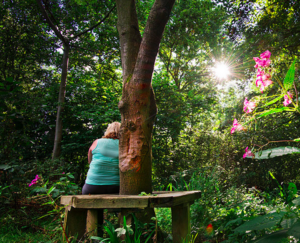
Receptive gardening refers to the appreciation of the garden efforts of others. This can involve sitting in a garden, viewing a garden from an outdoor position or even viewing a garden from inside, through a window. It is useful for therapeutic purpose, for persons who are ill, bed-ridden or in recovery and for people unable to work in a garden themselves due to age, disability, allergies, and so forth, but still wish to remain in touch with all the benefits brought about from enjoying a garden space.
Receptive gardening allows a person watching it to see seasonal changes, to watch the growth and renewal of plants, and to see how a garden cycles throughout the year. It can be enjoyable to watch others working in the garden even if the person watching is not able to assist.
Helping to bring about receptive gardening[edit | edit source]
Here are some suggestions for helping receptive gardening occur at a facility, institution, house, or other place:
- Be aware of the importance of gardens to people, no matter where they are. This includes institutions such as hospitals, aged care residences, medical facilities, workplaces, play centres and so forth. Even if the garden is not used by people at these places, it is still viewable and is a source of comfort, interest and engagement beyond the typical concrete lots and car parks.
- Facilitate viewing of, access to the garden and ability to stay in the garden comfortably and safely. Make use of space in front of windows, ensure that pathways are accessible by all persons and consider adding seating, cover from the elements and providing emergency contact stations in the case of an elderly or ill person needing quick attention while in the garden.
- Encourage wildlife into the garden for viewing. Set up bird feeders, nesting boxes, habitat piles, havens for wildlife, bathing areas, etc., to encourage wildlife to the garden. Ensure that viewing of feeding birds/squirrels/butterflies, etc., bathing areas, etc., are easy to view from a seated area, for example. You might also consider making it easy for guide dogs and companion animals to enter the garden as well.
- Set up regular times to take people to the garden if they're unable to go there themselves, or schedule time in front of window spaces for watching the garden. Don't assume that just because people aren't doing this for themselves that they're not interested. They may be anxious, afraid, unable to get there or unaware that they can visit the garden.
- Consider expanding the areas used for gardening to ensure that all persons who would benefit from receptive gardening are able to. This might, for example, mean placing small garden areas in the front of windows of patients unable to leave their beds but who would appreciate seeing a garden from their bed.